4 Forms of Influencer Marketing ROI
Learn how to properly calculate influencer marketing ROI and figure out if an influencer marketing campaign is right for your brand!
How do brands calculate the ROI of influencer marketing? This post breaks down ways to measure influencer marketing ROI and formulas to help.
%20(1).jpg)
.jpg?width=800&name=How%20to%20Calculate%20Influencer%20Marketing%20ROI%20and%20Track%20Results%20cover%20(1).jpg)
“We really need to nail down ROI before we commit to our next campaign.”
ROI is the elephant in the room for so many brands looking to level up their influencer marketing.
Food for thought: two-thirds of marketers say measuring influencer campaign ROI is among the top challenges of working with creators.
Hey, we get it! Getting buy-in from stakeholders and putting more resources behind future campaigns means justifying your investment.
We believe that brands should approach their campaigns with a sense of confidence by tracking the right influencer marketing metrics. That’s why we put together this post that breaks down:
What is the ROI of Influencer Marketing?
A lot to unpack here! Let’s start with the basics: ROI refers to return on investment.
And so influencer marketing ROI is the return on investment from influencer campaigns.
Not exactly breaking news, right? The "I" in ROI is what often gets overlooked, though.
“Investment” simply refers to what you spend. All marketing campaigns involve an investment (think: cash, time, resources). For example, the following expenses factor into influencer marketing ROI:
Now defining the “return” on what you investment in the above is where things get tricky.
That’s because many marketers equate “returns” to cash. Despite popular belief, ROI is not the same as thing as profit.
Besides, the returns that brands see from influencers take multiple forms. Including:
The short answer? It depends! Recent research says that the top metrics used to measure the “success” of an influencer campaign are:
All three metrics are totally worth tracking. The most important metrics are dependent on your business’ specific goals, though.
Food for thought: building awareness is the number one marketing goal for brands right now. This trend aligns with the numbers above.
That’s probably because engagement metrics are among the easiest to track. Does your company use a CRM, social media management platform or Google Analytics? The data’s already there!
“Sure, but what about sales?”
Direct sales attribution for influencers is complicated (and it’s not getting any easier).
Companies can likewise attribute direct sales from influencers through promo codes and affiliate links.
Thing is, these tracking methods aren’t foolproof. We actually wrote a blog post about how to track influencer sales that explains all of this in greater depth.
Don’t get us wrong, though: sales are still very much a byproduct of influencer campaigns.
There’s a reason why influencer budgets are ramping up, though. Both directly and indirectly, influencers drive sales.
The high performance of UGC ads and the popularity of influencer whitelisting are both good examples. For example, brands can save serious resources by using their influencer or user-generated content as the basis of paid ads.
The problem? Many marketers get so obsessed with sales attribution that they overlook valuable returns elsewhere.
For brands, the returns of influencer marketing are both qualitative and quantitative.
Quantitative ROI refers to returns tied to specific metrics and KPIs. These are elements of your campaign that you can track (AKA hard numbers).
Qualitative ROI refers to returns that aren’t 100% tied to data but remain valuable in a business context. This includes intangibles such as feelings and impressions associated with your brand.
Below is a breakdown of both types of ROI for influencer campaigns:
|
Quantitative ROI |
Qualitative ROI |
|
|
Let’s say a stakeholder is laser-focused on hard data (or maybe you’re obsessed). Below are the elements of influencer marketing ROI you can measure by the numbers.
No surprises here! Engagement refers to social interactions such as comments, shares, saves and “Likes” on your influencer content.
These metrics are front and center in any given social media analytics dashboard. You can easily track engagement data in a spreadsheet as your campaign progresses.

Some marketers might dismiss engagement data as “vanity metrics.”
However, earning organic social reach is tied directly to your account’s interactions.
Data from both TikTok and Instagram confirm this. On both platforms, smaller creator accounts earn significantly more reach than brand accounts. The importance of consistent, ongoing social engagement can’t be overstated.
It’s tough to put a price tag on authentic customer content.
In the short term, influencers provide you with content that promotes your products. Long-term, those pieces of content serve as ongoing social proof. Not to mention powerful marketing assets for your brand.
Consider how brands use influencers and ambassadors to kickstart their user-generated content campaigns. For example, brands like Everlane have dedicated hashtags where customers share product photos.
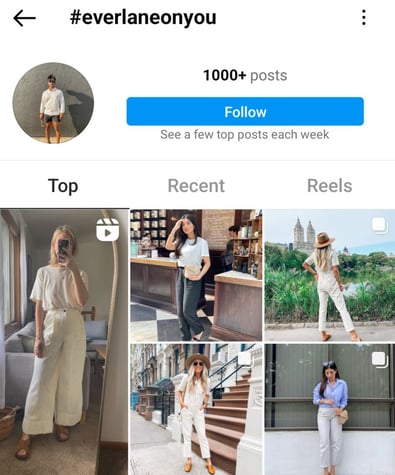
Source: Everlane
Assuming you have the full rights to the content, you can squeeze even more ROI from influencer marketing content by repurposing it. Authentic customer photos and videos are known to drive greater engagement across:
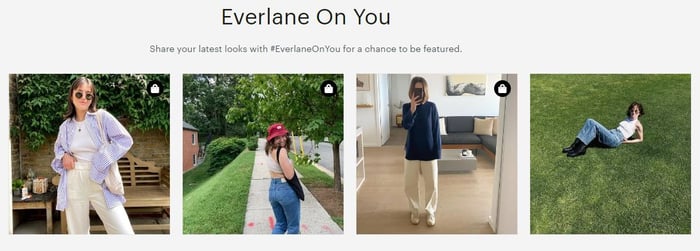
Source: Everlane
Beyond ads, a high volume of content is also good news for brands when it comes to social search. The growth of TikTok SEO highlights how more posts for creators translate into higher rankings when people look up your products via social media.
Using Google Analytics and custom URLs, brands can track the link between social channels and website traffic.
For example, you might notice a spike in site activity during or immediately following an influencer campaign. You can then assess which social channels, products and promotions brought in meaningful traffic.
Time saved is an overlooked factor in calculating influencer marketing ROI.
In some cases, the time you save can actually represent a bigger financial impact than sales.
How so? We've seen firsthand how time-consuming running influencer campaigns in-house can be. For reference, our platform saves our brands an average of 100 hours per month. Those hours come from time-consuming tasks including:
If you're doing all of this yourself, those 100 hours from your schedule translate to thousands of dollars. Not to mention lost productivity and time spent away from existing tasks. This is all before securing a single piece of content, by the way!
We’ll say it again: dollars and cents don’t tell the whole story when it comes to influencer campaign ROI. The potential time and money saved via outsourcing is too much to ignore.
Sales boosts are a welcome byproduct of any influencer campaign. This bump can happen both during and after your promotions are finished.
The ability to track direct sales really depends on the scope of your marketing analytics stack, though. An area where it's much easier to track sales data is via social ads featuring your influencer or user-generated content.
Below are the less concrete (but super important!) returns that brands should know:
Although you can’t put social proof on a spreadsheet, its impact on purchasing decisions is undeniable.
That’s because shoppers overwhelmingly prefer to purchase products endorsed by everyday people. Below is an example of how authentic creator content can “prove” that a product is worth checking out.
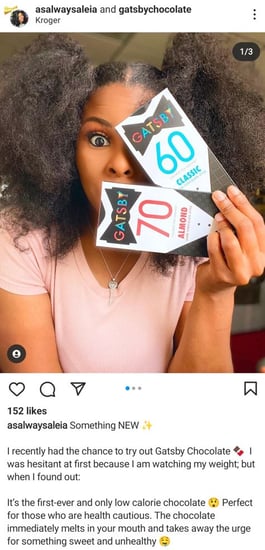
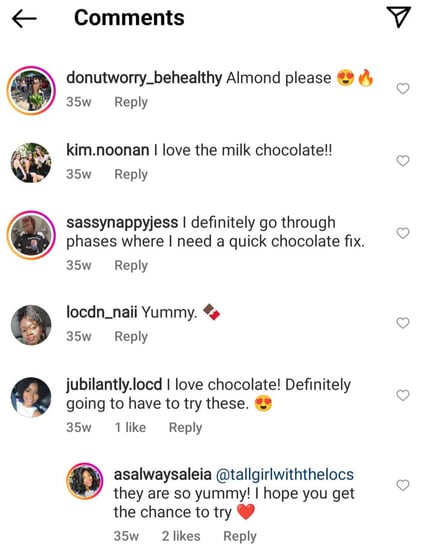
Source: @gatsbychocolate
Before people can buy from you, they need to know who you are.
The modern buyer’s journey is a complex process. Building brand awareness helps your brand stand out in the sea of promotions.
This includes competing ads, content and everything else fighting for your audience’s attention.
The more touchpoints you make with your audience, the more likely they are to recall your brand. Those familiar with you will be more likely to become customers.
Note that brand awareness can be measured with engagement metrics. This includes clicks, shares and comments. Brands shouldn’t ignore the business impact of these interactions.
Check out the comment section of a creator that recently partnered with Athleta. This interaction highlights how a potential customer had heard of the brand but it was the creator’s post that really sold them.
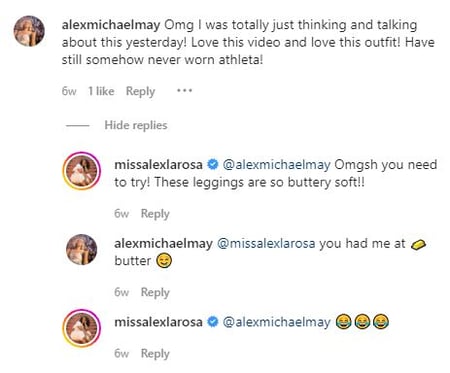
Source: @missalexlarosa
Also, consider how building awareness helps brands stand apart from their competitors.
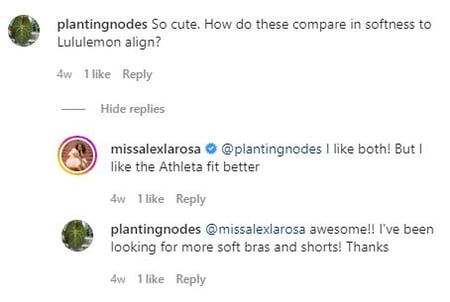
Source: @missalexlarosa
Pop quiz! How do your customers feel about your product?
Creators are masters at both building and highlighting positive customer sentiment. After all, they quite literally speak your audience’s language. That’s because relevant creators should reflect your audience.
Peek the comment section of a recent viral TikTok where a creator was blown away by the fit of her Aerie bralette.
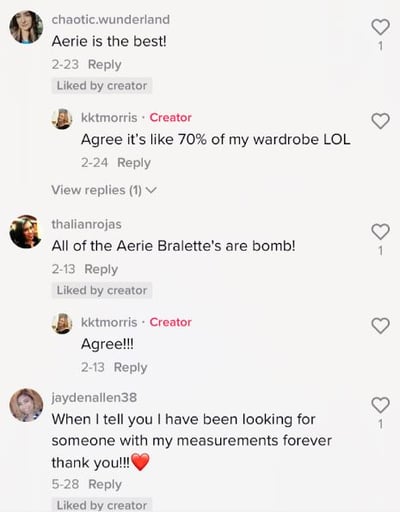
Source: @kktmorris
The organic, off-the-cuff video earned over 300k views, 20k “Likes” and 200+ comments.
Meanwhile, many of those comments were gushing over how much customers love the brand. This is a great example of how qualitative and quantitative ROI come together.
88% of consumers regard recommendations from real people as the most trustworthy way to discover new products. The more customer content and reviews you have, the easier it is to build credibility.
Sourcing social proof like this takes time. Influencers can help earn that credibility faster than what’s possible organically. The key is working with a high volume of authentic creators that want to promote you.
For brands in competitive industries, influencers are a huge part of your positioning strategy. This includes:
Again, influencers are best at showcasing all of the above. Nurturing a dedicated creator community establishes authority versus your competitors.
When many marketers and stakeholders think of ROI, what they’re really thinking of is ROAS (return on ad spend).
In other words, you earn back what you invest and then some (hopefully).
Influencer marketing doesn’t really lend itself to a specific dollar-amount ROI.
This obviously presents a challenge to marketers looking for buy-in. Critics of influencer marketing often use the lack of hard ROI as a “gotcha.”
The reality, though? This isn’t a big secret.
Food for thought: 89% of marketers plan to increase or maintain their influencer budgets this year.
This isn’t happening “just because.” The ongoing, long-term benefits of creator campaigns are well-documented. Consider that most brands dedicate roughly 15% of their marketing budgets to influencers. It’s not an all-or-nothing situation.
Marketers should approach influencer campaigns with realistic expectations when it comes to returns. If you’re only after sales, you need to know what you’re getting into. Below are some realities and challenges associated with calculating influencer marketing ROI.
ROI is not one-size-fits-all.
The most important returns from any marketing campaign are relative. They don’t have to be financial by default.
As noted earlier, brand awareness is the number one goal of marketers at large right now.
Look at big-box beauty brands, for example. In such a competitive and crowded market, brand awareness is make-or-break. Establishing your industry presence might take priority over sales in the short term.
Think about it. When’s the last time you bought something from a brand with no customer photos or reviews? You can’t drive sales until people know and trust you. Influencer marketing offers an opportunity to build that trust faster.
Fact: of consumers that buy products from influencers, only one-third do so directly.
And so even with affiliate links and promo codes, there’s no consistent way to assess the exact, long-term sales impact of an influencer campaign.
Can you tie sales to link clicks and promo code redemptions? Absolutely!
However, this doesn’t account for sales from:
We’ll say it again: the modern customer journey is complicated.
People are bouncing between multiple platforms as they browse products and read reviews. Consumers at large have endless options when it comes to products and brands. It’s no surprise that people are taking longer to make purchasing decisions.
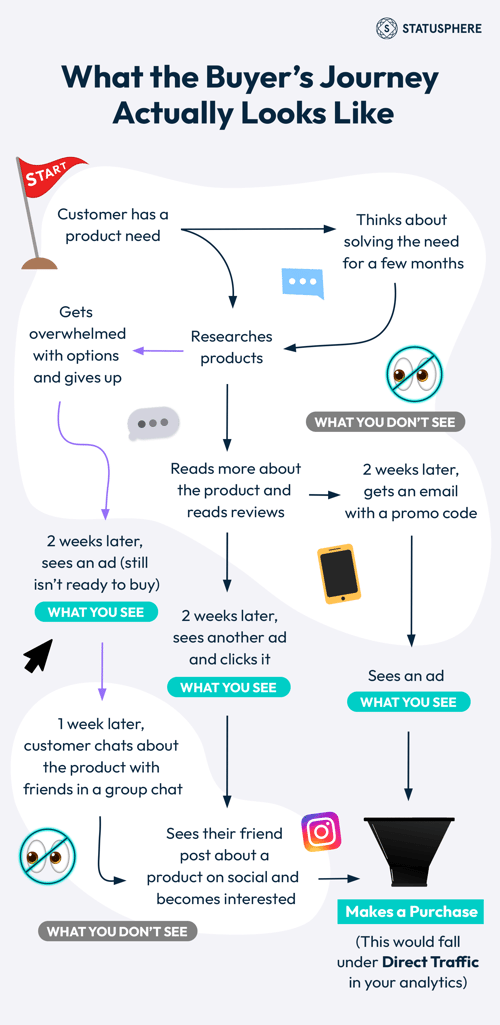
This speaks to the importance of making multiple touchpoints with customers. Likewise, all of these twists and turns make sales attribution a headache.
Piggybacking on the point above, the steps leading up to conversions via influencers are getting tougher to track.
Enter the Dark Funnel.
With all the ongoing changes to web cookies and third-party data tracking, the future of attribution is murky. Combine this trend with growing consumer concerns over privacy. Figuring out how customers get from Point A to Point B isn’t going to get easier.
Not only that but many marketers already have their fair share of attribution gaps.
For example, do you have UTM parameters set up for your promo links? Have you segmented your traffic from social media? It’s an exhausting process without the right marketing stack. The takeaway here is that tracking every moment of “influence” is nearly impossible.
Phew.
Now it’s time to do some math!
To be transparent, there is no specific formula for calculating returns from influencer marketing campaigns.
Simplified ROI calculators where you plug in your numbers lack nuance. For example, most formulas make a ton of assumptions such as all of your sales growth being attributed to your marketing efforts. Formulas likewise fail to take qualitative returns into account.
That said, formulas can provide context to how influencers impact your big-picture efforts. Below are three formulas to help you calculate influencer marketing ROI:
Our first formula is about as simple as it gets.
This basic formula measures your company’s sales growth against marketing spend.
Sales growth ($) [over X months] − Marketing campaign spend ($) [over X months]
÷
Marketing campaign spend ($) [over X months]
= ROI (x100) = ROI (%)
This formula isn’t perfect. Still, it’s a no-frills calculation of ROI in the simplest terms. This formula can measure marketing ROI before, during and after an influencer campaign.
Seeing positive returns three-to-six months (or longer) after your initial influencer promotion? Are your efforts elsewhere largely unchanged? That’s a good sign. This is making a lot of assumptions and not taking outside variables into account, though.
This next formula calculates “attributable” ROI.
Like the formula above, this calculation must focus on a specific timeframe to be meaningful.
Sales growth ($) [over X months] − Average [X months] sales growth ($) − Marketing campaign spend ($) [over X months]
÷
Marketing campaign spend ($) [over X months]
= ROI (x100) = ROI (%)
The idea here is to assess how sales over a “typical” time period compared to a time period where a specific marketing campaign was active.
Is this formula perfect? Not exactly. Again, calculations make a lot of assumptions.
That said, this is probably the closest thing to a “proper” formula for calculating influencer marketing ROI. Putting it into action requires you to be on top of your long-term sales and marketing data. This calculation is really only as accurate as your attribution.
As noted earlier, comparing ROAS and influencer marketing ROI is apples and oranges. Still, it’s a formula that can be relevant to influencer campaigns.
Marketing campaign revenue [over X months]
÷
Marketing campaign spend [over X months] x 100
= ROI (x100) = ROI (%)
Are your influencers red carpet-level with a rabid audience? Have you gone millions-of-views-viral-on-TikTok multiple times? ROAS isn’t a particularly helpful formula for calculating influencer marketing ROI.
With all that said, influencer marketing can have a positive impact on your ROAS. Take Instagram ads, for example. Meta themselves state that authentic creator content increases ROAS for brands across the board.
This is yet another example of how influencers can produce returns that go under the radar. Think about how creators can boost your ROI elsewhere. This includes ads and sales.
Our word-of-mouth campaign with Health-Ade Kombucha is a great example. The brand wanted to drive in-person sales and sought creators to build awareness. Working with Statusphere, the brand saw positive results as we:
These results contributed toward the company reaching its sales goal.
ROI will always be a hot-button topic among marketers. As influencer campaigns boom, brands want to see measurable results to justify their budgets.
We get it! Our advice? Look at influencer campaigns holistically rather than in a vacuum.
And the clearer your expectations and goals are, the better.
Let's say your brand wants to generate hundreds of influencer posts to improve social SEO and earn better creatives for your paid ads. With specific goals like this, you have clear KPIs to measure to determine the ROI of your influencer campaign.
No matter what your campaign goals might be, just know that our micro-influencer marketing platform can help you hit them. Our software was built to help brands scale their campaigns and earn authentic, rights-ready content in a fraction of the time it'd take in-house.
With Statusphere, influencer ROI doesn't have to be a question mark when it comes to content.
That's because our algorithm matches brands from our vetted creator network using 250+ first-party data points. We eliminate the most time-intensive tasks and guarantee content for our brands.
Beyond that, we track all of your influencer reporting and performance data in one place.
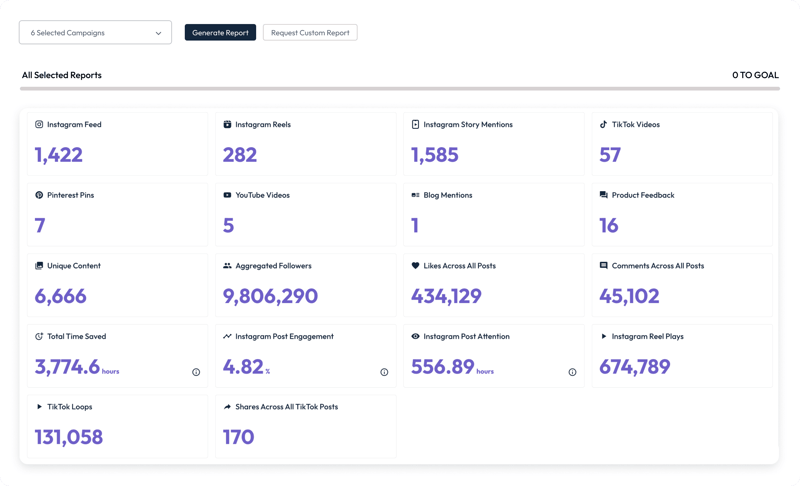
Want to learn more about how our platform works? Get in touch with one of our experts to see how we can increase your influencer marketing ROI with authentic content at scale.
This article was first published in November 2020. It was last updated June 12, 2023.

Learn how to properly calculate influencer marketing ROI and figure out if an influencer marketing campaign is right for your brand!
Influencer marketing for beauty brands is bigger than ever. These 18 beauty influencer marketing examples highlight how investing in influencers is...
Influencer marketing can be hard to track, but statistics show that it’s one of the best ways to reach your target audience while simultaneously...
Be the first to know about the latest tools, trends and strategies in influencer marketing for brands.